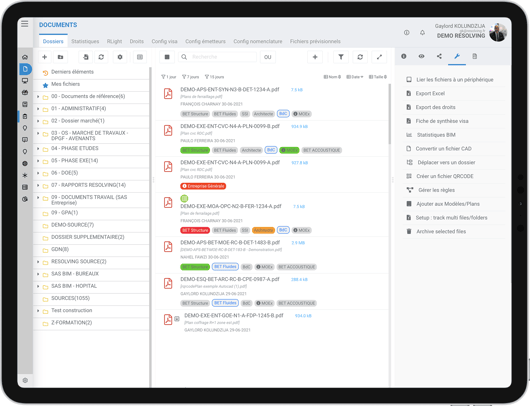Published on
The 5 key stages to structure a project’s EDM

Using EDM (Electronic Document Management) within a construction project has now become standard practice. However, in order to make the most of it, it is necessary to think carefully beforehand about the needs of the company or project for which it is deployed. This kind of tool only brings a benefit if it is structured to the specificities of the construction project that it will serve. The challenge is therefore to customise EDM according to the processes and methodologies specific to the project/site. Whether the project is already underway or is still in the study phase, it is essential to carry out a precise audit in order to lay the foundations of the document management that will be used throughout the project and the entire life cycle of the building. Here are the steps to follow to properly structure the EDM of a project.
EDM and its strategic challenges
Using EDM (via a suitable tool) consists of managing the company's documents digitally. All the important legal contractual information is then centralised and updated in real time.
In particular, EDM makes it possible to manage a very large number of documents digitally: plans and models, construction permits, Contractor Consultation File, customer data, product sheets, delivery report, handover file, etc. It also covers multiple policy issues. Teams using it can therefore be much more responsive and productive. Users can find the information they need very simply and more quickly. As the documents are updated in real time, collaboration between the various internal or external stakeholders is also streamlined. In short, the entire work organisation is optimised and the different stakeholders can focus on their core business and their high value-added tasks for the project.
In addition, the tool offers a range of economic and environmental advantages. Thanks to electronic document management, employees consume less paper and the company spends less on postage, transport and document storage costs.

The stages to follow to effectively structure a project’s EDM
A business has everything to gain from an EDM solution that can meet the company’s and the project’s specificities while remaining easy to use for all stakeholders. However, the operation and deployment of this tool is not something that can be improvised. Here is how to properly organise a project’s EDM.
1. Analyse the specificities of the projects
The first thing to do in order to properly organise the project’s EDM is to analyse its specific features. Each construction project has its own peculiarities. Teams’ work methods, the issues and constraints vary depending on whether you are building a thirty-storey office tower or renovating a luxury department store.
Special attention should therefore be paid in defining the scope of the company's intervention on the project concerned by specifying:
- the intervention phase (design, execution, delivery, operation, deconstruction or rehabilitation);
- the lots concerned: whether or not the contractor will supervise all the trades that will work on the project;
- the types of documents used according to the contractor's intervention schedule. (e.g., managing design ideas to proceed to the construction stage)
2. Specify the organisation of the project and analysing its needs
The second step is to define the organisation specific to the construction project. At this stage, it is important to target the project's needs with regard to the tools used as well as the working methods of stakeholders (access rights, form requirements, reporting needs, data security rules, etc.).
It is also essential to carefully consider the validation procedures required for the project (sign-off workflows). Finally, take time to understand the rules for naming files and the information that must appear in such names.
3. Obtain the list of stakeholders involved in the project
The human dimension plays an important role in the success of an EDM project. It is therefore important to clearly identify all the internal and external contacts who will intervene on the project. It is also essential to identify the different intervention timings per team during the project in order to specify the durations of and access rights to the documents as well as the restrictions to be set up if necessary.
It is important to obtain an exhaustive list of the stakeholders involved in the project:
- the different design offices,
- inspection offices,
- the architect(s)
- contractors/Subcontractors
- promoters (co-promotion)
- execution Project Manager
This makes it possible, on the one hand, to carry out collaborative work by including all stakeholders - it is an effective means of securing access to the various documents - and, on the other hand, to save time in the deployment of the tool.
Note, in this regard, that you can also appoint an EDM consultant who will be responsible for connecting up all the teams. They will also have to interact with the team in charge of deploying the EDM solution where necessary.
-DESKTOP%20(FR)-2.png?width=594&height=426&name=PRODUCTS-DOCUMENTS%20(2)-DESKTOP%20(FR)-2.png)
4. Define the documentary rules and methods
Once the needs have been analysed, the specificities of the project have been defined and the work organisation specified, the documentary rules and methods must be defined. In other words, experts will draft the processes to be followed in order to ensure the traceability of actions (sign-offs). This study is a major part of the process and makes it possible to ensure the smooth exchange of documents between all stakeholders throughout the construction cycle.
Much of the success of the project's EDM is based on this stage. It makes it possible to rate the mode of operation between the various stakeholders for fluid and efficient collaboration.
Finally, it is a kind of specification that indicates very precisely the governance of information:
- classification plans;
- processes for receiving and acquiring documents;
- roles and rights assigned to employees according to their involvement in the project;
- the validation and control flow associated with the documents, etc.

5. Follow the documentary schedule
Finally, the last step to configure a project’s EDM is to follow the documentary schedule. In order to effectively monitor the progress of the document schedule, the list of documents to be produced must be established in line with this schedule: provisional files. In this way, the management team has relevant indicators to manage the document management of the project as efficiently as possible, identify compliance with the schedule, anticipate delays and take corrective decisions.
These are the non-negotiable stages required to effectively configure a project’s EDM. They will determine the success of the operation. While some structures choose to carry them out in-house, others prefer to be accompanied by experts in the field such as Kalidoc, who can intervene on all these missions to support construction professionals.
However, the work doesn't stop there. Once the structuring has been correctly completed, the challenge lies in deploying a solution that corresponds in every way to the image of the organisation. Again, there are a few rules to follow that will get you there.
Structuring a project’s EDM: everything you need to know
How to roll out a successful paperless project?
To succeed in a paperless project, it is necessary to:
- set clear goals;
- pay close attention to the needs of the project;
- include all stakeholders upstream of the project;
- inclure l’ensemble des acteurs en amont du projet ;
- train users and accompany them if needed;
- call on experts where necessary.

